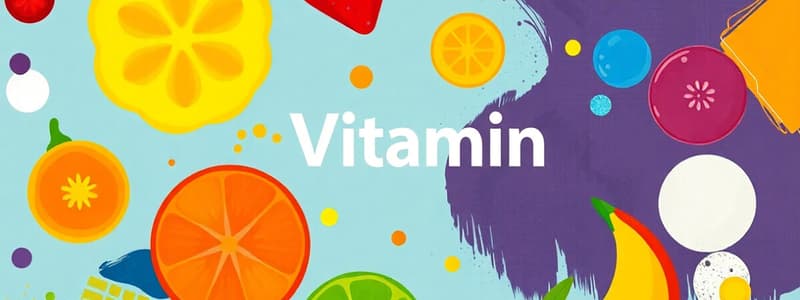Podcast
Questions and Answers
What is the primary function of Vitamin D in animal physiology?
What is the primary function of Vitamin D in animal physiology?
- Synthesis of collagen in epithelial cells
- Antioxidant protection against free radicals
- Regulation of calcium and phosphorus metabolism (correct)
- Prevention of lipid oxidation
Which vitamin is primarily responsible for preventing oxidation of lipids in cell membranes?
Which vitamin is primarily responsible for preventing oxidation of lipids in cell membranes?
- Vitamin C
- Vitamin A
- Vitamin K
- Vitamin E (correct)
Which condition is directly associated with Vitamin E deficiency?
Which condition is directly associated with Vitamin E deficiency?
- Encephalomalacia (correct)
- Menkes syndrome
- White muscle disease (correct)
- Rickets
What form of Vitamin K is synthesized by microbes and is the metabolically active form?
What form of Vitamin K is synthesized by microbes and is the metabolically active form?
In which type of animal is Vitamin D primarily required in dietary form due to their inability to synthesize it?
In which type of animal is Vitamin D primarily required in dietary form due to their inability to synthesize it?
What characteristic makes Vitamin E the least toxic of the fat-soluble vitamins?
What characteristic makes Vitamin E the least toxic of the fat-soluble vitamins?
What is a key difference between Vitamin D2 and D3 in their efficiency in poultry?
What is a key difference between Vitamin D2 and D3 in their efficiency in poultry?
What is the role of antioxidants like Vitamin E in animal diets?
What is the role of antioxidants like Vitamin E in animal diets?
What disease is associated with a deficiency in vitamin C?
What disease is associated with a deficiency in vitamin C?
What term was originally used to describe vitamins when first discovered?
What term was originally used to describe vitamins when first discovered?
Which of the following functions is NOT associated with vitamin A?
Which of the following functions is NOT associated with vitamin A?
What is a possible cause of the disease rickets?
What is a possible cause of the disease rickets?
What major insight was gained from the discovery and isolation of vitamins in 1912?
What major insight was gained from the discovery and isolation of vitamins in 1912?
What is one role of carnitine that is synthesized with the aid of vitamins?
What is one role of carnitine that is synthesized with the aid of vitamins?
Which vitamin was discovered in 1922 as a 'fat-soluble factor'?
Which vitamin was discovered in 1922 as a 'fat-soluble factor'?
Which deficiency disease dates back to 201-300 AD?
Which deficiency disease dates back to 201-300 AD?
What is the main function of Vitamin K in the body?
What is the main function of Vitamin K in the body?
What can result from a deficiency in Vitamin K?
What can result from a deficiency in Vitamin K?
Which vitamin is primarily responsible for energy transfer?
Which vitamin is primarily responsible for energy transfer?
What is the biological equivalent of 1 IU of Vitamin D?
What is the biological equivalent of 1 IU of Vitamin D?
Which of the following statements is true regarding water-soluble vitamins?
Which of the following statements is true regarding water-soluble vitamins?
Which vitamin is synthesized by rumen microbes?
Which vitamin is synthesized by rumen microbes?
What is a significant dietary source of Vitamin K?
What is a significant dietary source of Vitamin K?
Which of the following vitamins is water-soluble and has no provitamins?
Which of the following vitamins is water-soluble and has no provitamins?
Flashcards are hidden until you start studying
Study Notes
Vitamin Discovery and History
- The association between diseases and dietary deficiencies has been recognized for centuries.
- Beriberi was documented as early as 201-300 AD.
- Rickets was described in 110 AD.
- Scurvy was recognized as "Sailors Disease" in 1753.
Vitamin Deficiencies and Symptoms
- Scurvy results in defective collagen structure, spongy gums, and bleeding from mucous membranes.
- Rickets is a deficiency of vitamin D, leading to skeletal abnormalities.
Vitamin Classification
- Vitamins are organic compounds required in small amounts.
- They are often referred to as "accessory factors" or "vital amines."
- Vitamins act as cofactors in metabolic reactions, acting as donor or acceptor groups for metabolic intermediates.
- Some vitamins are synthesized by microbes, influencing dietary needs depending on the animal's digestive system.
Vitamin A
- Discovered in 1922 as a "fat-soluble factor" found in butter and fish oil.
- Retinol is the biologically active form of vitamin A.
- Functions of Vitamin A:
- Vision
- Bone growth
- Reproduction
- Maintenance of epithelial cells
- Antioxidant
- Hypervitaminosis A can lead to skeletal abnormalities and skin thickening, depending on species, age, and physiological condition.
Vitamin D
- Sterol compound that regulates calcium and phosphorus metabolism.
- Formed by irradiation of sterols in plants and skin.
- Sun-cured forages and hay are good sources of vitamin D.
- Confined animals require supplemental vitamin D.
- Carnivores and omnivores require vitamin D3.
- Most animals can convert vitamin D2 to D3, but poultry have low conversion efficiency.
- Cats cannot synthesize vitamin D and require dietary supplementation.
- Vitamin D functions as a steroid hormone, regulating DNA transcription in microvilli.
- It plays a role in the synthesis of RNA, important for calcium-binding proteins.
Vitamin E
- Group of compounds known as tocopherols and tocotrienols.
- Alpha-tocopherol is the most active biological form typically added to diets.
- Functions of Vitamin E:
- Acts as an antioxidant to protect cells from free radical damage.
- Prevents lipid oxidation by scavenging free radicals.
- Protects proteins and vitamin A.
- Lipid peroxidation can disrupt cell membrane structure and integrity, affecting animal health and palatability.
- Vitamin E deficiency can lead to:
- White muscle disease
- Exudative diathesis
- Encephalomalacia ("crazy chick disease")
- High levels of Vitamin E added to diets can enhance nutritional value and lipid stability.
Vitamin K
- Group of compounds called quinones.
- Vitamin K1 is found in plants (phylloquinones).
- Vitamin K2 is synthesized by microbes (menaquinones).
- Menaquinone is the metabolically active form.
- Vitamin K3 (menadione) is the most common synthetic form added to animal diets.
- The liver converts K1 and K3 to K2.
- Functions of Vitamin K:
- Synthesis of prothrombin, a blood clotting protein.
- Deficiency leads to hemorrhage and prolonged bleeding, potentially affecting carcass quality.
- Gut microbes are a good source of vitamin K, which can be obtained through absorption or coprophagy.
- Dicoumarol, found in moldy sweet clover hay or silage, is a structural analog of vitamin K and acts as a competitive inhibitor.
Water-Soluble Vitamins
- B complex, vitamin C (ascorbic acid).
- No provitamins.
- Primarily involved in energy transfer.
- More easily absorbed from the small intestine compared to fat-soluble vitamins.
- Water-soluble vitamins are not stored extensively and are excreted in feces and urine.
- Rumen microbes can synthesize all B vitamins.
International Units (IU) for Vitamins
- Vitamin A: 1 IU is equivalent to 0.3 μg retinol or 0.6 μg beta-carotene.
- Vitamin D: 1 IU is equivalent to 0.025 μg cholecalciferol or ergocalciferol.
- Vitamin E: 1 IU is equivalent to 0.67 mg d-alpha-tocopherol or 0.9 mg of dl-alpha-tocopherol.
Vitamin Content in Different Feeds
- Concentrates are rich in B vitamins.
- Forages are a source of carotene:
- Fresh grass: ~250 mg/kg
- Ensiled grass: ~125 mg/kg
- Artificially dried: ~95 mg/kg
- Lucerne hay: ~15 mg/kg
- Animal products are rich in most vitamins but deficient in vitamin C.
- Microbial fermentation, particularly in the rumen, provides vitamin B12, K, and biotin.
Studying That Suits You
Use AI to generate personalized quizzes and flashcards to suit your learning preferences.




